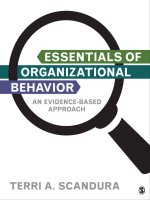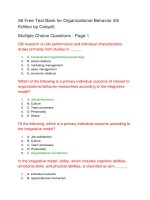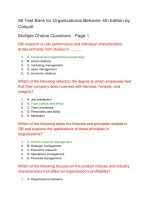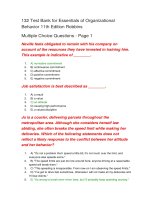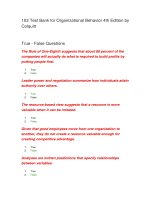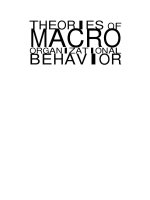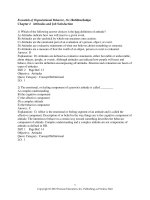Theories of macro organizational behavior by conor vibert
Bạn đang xem bản rút gọn của tài liệu. Xem và tải ngay bản đầy đủ của tài liệu tại đây (5.32 MB, 236 trang )
THEORIES OF
MACRO
ORGANIZATIONAL
BEHAVIOR
THEORIES OF
MACRO
ORGANIZATIONAL
BEHAVIOR
A HANDBOOK
OF IDEAS AND
EXPLANATIONS
CONOR
VIBERT
M.E.Sharpe
Armonk, New York
London, England
Copyright © 2004 by M.E. Sharpe, Inc.
All rights reserved. No part of this book may be reproduced in any form
without written permission from the publisher, M.E. Sharpe, Inc.,
80 Business Park Drive, Armonk, New York 10504.
Library of Congress Cataloging-in-Publication Data
Vibert, Conor, 1962–
Theories of macro-organizational behavior : a handbook of ideas and explanations /
Conor Vibert.
p. cm.
Includes bibliographical references and index.
ISBN 0-7656-1294-1 (alk. paper)
1. Organizational behavior. 2. Corporations. 3. Complex organizations. 4. Management.
I. Title.
HD58.7.V53 2004
302.3’5—dc22
2003057376
Printed in the United States of America
The paper used in this publication meets the minimum requirements of
American National Standard for Information Sciences
Permanence of Paper for Printed Library Materials,
ANSI Z 39.48-1984.
~
BM (c)
10
9
8
7
6
5
4
3
2
1
Contents
Acknowledgments
1. Introduction
2. A Primer on Organization Theory
Deborah Hurst and Conor Vibert
Part I.
3.
4.
5.
6.
7.
8.
9.
10.
11.
12.
13.
14.
15.
16.
Functional Economic Theories of the Firm
Neoclassical Economics Perspective
Chicago School Perspective
Bain-Mason Perspective
Transaction Cost Perspective
Network Perspective
Agency Theory Perspective
Stakeholder Perspective
Resource-Based Theory Perspective
Behavioral Perspective
Game Theory Perspective
Property Rights Perspective
Knowledge Perspective
Evolutionary Perspective
Natural Environment Perspective
Gregory R. Berry
Part II. Functional Organization Theories
17.
18.
19.
20.
21.
22.
23.
Bureaucracy Perspective
Contingency Perspective
Strategic Choice Perspective
Resource Dependence Perspective
Population Ecology Perspective
Institutional Perspective
Chaos Perspective
vii
3
10
15
19
22
26
29
33
41
45
50
54
59
64
69
73
77
83
85
89
93
98
102
107
111
vi
CONTENTS
Part III.
24.
25.
26.
27.
28.
29.
Symbolic Interactionism Perspective
Deborah Hurst and Conor Vibert
Dramaturgical Perspective
Metaphorical Perspective
Sensemaking Perspective
Jean Helms Mills
Organizational Rules Perspective
Albert J. Mills
Culture Perspective
Part IV.
30.
31.
32.
33.
34.
35.
Interpretive and Social
Constructionist Perspectives
Radical Humanist and Structuralist
Perspectives
Conor Vibert and Deborah Hurst
Configuration Perspective
Postmodern Perspective
Critical Theory Perspective
Marxist Perspective
Poststructuralist Feminism Perspective
Deborah Hurst
Conclusion
References
Recommended Readings
About the Author and Contributors
Index
117
119
124
129
134
140
147
153
157
163
170
176
180
186
189
215
219
221
Acknowledgments
At some point, all good things must come to an end. Writing this
book was an exciting challenge. I would like to acknowledge a number
of individuals who have supported this initiative.
My wife, Sonia, and our children, Colin, Brendan, Jennifer, and
Sean (who was just a twinkle in our eye when I published my first
book three years ago), are my true inspiration. Sonia’s support and
understanding, coupled with the children’s love, kept this project moving over four years.
I would like to acknowledge the work of two Acadia University
students, Brett Eisner and Kevin Miller, for their support early in this
project. I would also like to thank Andrew Steeves and Deborah
Hurst for their guidance on the organization of this book and editing
of early drafts. More recently, I owe a debt of gratitude to Dianne
MacPhee, Jonathan Campbell, and Hope Corkum for their editing and
support. A special note of thanks is also due to my editor, Eric Valentine, and my publisher, Lynn Taylor, along with her associate Esther Clark.
Also worthy of thanks are my professional colleagues who contributed chapters to this endeavor as well as personal advice. These
include Deborah Hurst, Gregory R. Berry, Jean Helms Mills, and
Albert J. Mills. Scott Colwell, Edith Callaghan, Roy Soddaby,
Janice Thomas, and Alex Kondra were helpful with insight regarding specific challenges. I would also like to thank Bob Hinings,
Royston Greenwood, Danny Miller, and Richard Field, whose mentoring earlier on in my career gave me the idea to pursue this
endeavor.
Others offered support in far more subtle ways. They include Maurice Tugwell, Doug Mosher, Orlene Bligh-Coldwell, Michael Leiter,
Bill McLeod, Stephen Ash, Kelvin Ogilvie, Janice BamBrick, Delores
Spencer, Heather Parrish, Joanne Te Bogt, Wanda Demone, Kerry
LaFrance, Rosie Hare, Lisa Davidson, Heather Harvey, Joan Masterson, April Samson, Garry McIver, Cathy Carnegie, and finally, to
vii
viii
ACKNOWLEDGMENTS
Darrell Cook, without whose support this project would never have
been completed. To these individuals I offer my thanks.
Conor Vibert
Wolfville, Nova Scotia
THEORIES OF
MACRO
ORGANIZATIONAL
BEHAVIOR
1
Introduction
Why do large organizations behave as they do? The question is simple
and thought provoking. It is also one that is rarely answered or indeed
pursued in a comprehensive manner outside of academia. One need
simply ponder the activities of firms such as Microsoft, Nike, Calvin
Klein, or the International Olympic Committee to appreciate the significance of this query. An investor in the North American stock markets of the late 1990s and early millennium might also understand the
importance of not having seriously considered this concern. Indeed,
as never before, the fallout from the dot.com era of investing and the
questions of legitimacy surrounding investment community–sponsored
corporate research suggests a need to revisit our understanding of why
corporations act as they do. It also demands that we reconsider how
practitioners, investors, academics, and students obtain and process
information to make informed decisions. In short, we need to consider
alternative means of undertaking business-related analysis.
This book is a response to that concern. Our readers are academics,
business analysts, corporate trainers, students, researchers, and the curious. After completion, readers will note an increase in their abilities
to understand complex organized behavior occurring in the private
and public sectors. It offers a series of different theoretical lenses
useful for explaining one event from multiple perspectives or many
events from one perspective. Theories of Macro-Organizational Behavior: A Handbook of Ideas and Explanations presents a series of
well-established theories of organization and economic theories of the
firm. For each of these perspectives, a brief overview of the main ideas
is provided, along with an example and a concluding critique. ToAuthor Note: The section of this chapter entitled “How Exposure to the Concepts of
Organization Theory Can Benefit Practitioners” is adapted with permission from
Conor Vibert, Competitive Intelligence: A Framework for Web-based Analysis &
Decision-Making (Mason, OH: Thomson South-Western, 2003).
3
4
THEORIES OF MACRO-ORGANIZATIONAL BEHAVIOR
gether, these components allow readers to improve their understanding
of why corporations and other large entities act as they do, while
introducing them to leading-edge academic thought.
About Organization Theory
Why are corporations such as Wal-Mart, Dell, and IBM so often perceived as top performers? Organization and business strategy theorists
address questions of this nature. As scholars, these individuals seek
to understand why organizations look and act as they do and why they
are effective. Not surprisingly, among academics no school of thought
accurately reflects current thinking on these issues (Meyerson and
Martin 1988). As a consequence, there now exists a large collection
of scholarly insight that suggests many different approaches for explaining and predicting large-scale organized behavior.
Numerous themes connect the different perspectives that make up
this body of research and literature known as organization theory.
Noteworthy among these themes is the idea that efforts to improve the
corporate bottom line do not always drive the behavior of large organizations. Despite popular misconception, profit is not the sole motivator of corporate and organized activity. Indeed, evidence suggests
strong roles for reasons other than improvements to the bottom line.
Overview of the Book
The core of this endeavor is a presentation of the theories that fit under
the heading of “organization theory.” These theories represent a broad
overview of this important field of research and include perspectives
originating with European, North American, Australian, and Asian
thought. Theories covered range from those with strongly critical
slants on the one hand to the more mainstream, less critical perspectives on the other hand. The theories covered originate within fields
as diverse as economics, management, psychology, sociology, ecology,
anthropology, and political science. Profit-driven economic theories of
the firm are covered side by side with effectiveness-driven theories of
organization. Following the motto “There is no one best way to organize,” each chapter suggests to readers a different approach to understanding how organizations should or do behave. For each
theoretical perspective, readers are offered a stand-alone modularized
write-up.
INTRODUCTION
5
This book is divided into a number of different parts. To begin, a
brief primer is presented to familiarize readers with the topic of organization theory. We then offer a set of perspectives, each categorized
under four distinct headings: “Functional Economic Theories of the
Firm,” “Functional Organization Theories,” “Interpretive and Social
Constructionist Perspectives,” and “Radical Humanist and Structuralist
Perspectives.” Since most of the past and present of organization theory is located within the functionalist theories tradition, this part of
the book is much longer then the other parts. Meanwhile, the third
and fourth parts contain more recent theoretical developments. It is
also important to note that this book does not intend to replace the
more traditional organization theory text. Instead, this book seeks to
provide readers with a broad overview of the field, to be used, if
chosen, in partnership with lectures, case materials, and other readings
that strive to explain large-scale organized behavior. In this book, we
address:
•
•
•
•
•
The main issues confronting organizations
Why it is important to theorize about organizations
How these theories are constructed
The main theoretical ideas within the different paradigms
How learning is enhanced by looking across perspectives.
Part I: Functional Economic Theories of the Firm
Economists have long held an interest in the behavior of for-profit
organizations. Much of their insight has been anchored in a long series
of research efforts falling under the heading of “theories of the firm.”
Theories of the firm refer to conceptualizations and models of business
organization conduct. Despite the common use of the expression “theory of the firm,” no one conceptualization exists to unite those seeking
to understand why companies act and organize as they do (Grant
1996). However, a few ideas are accepted by most academics and
theorists. Among the most important of these is the idea that observers
can explain and predict the structure and behavior of business
enterprises.
Furthermore, agreement probably exists that a theory of the firm
should represent an “abstraction of a real world business enterprise
designed to address a particular set of its characteristics and behaviors” (Machlup 1980). Economic theories of the firm are implicitly
6
THEORIES OF MACRO-ORGANIZATIONAL BEHAVIOR
managerial in their orientation, while theorists in this tradition “seek
to examine regularities and relationships that lead to generalizations”
(Gioia and Pitre 1990). Economic theories of the firm are functional
and are concerned primarily with predicting the behavior of firms in
external markets (Grant 1996). As such, performance ultimately refers
to the bottom line in an environment where the firm is considered a
singular decision taker.
In this part, as with the others in this book, we deal with how the
theories contribute to macro-organization theorizing. Economic theories of the firm discussed include neoclassical, Chicago School, BainMason paradigm, transaction costs, network perspective, agency
perspective, stakeholder perspective, resource-based theory, behavioral
perspective, game theory, property rights perspective, knowledge perspective, evolutionary theory, and natural environment perspective,
which is authored by Gregory R. Berry. These discussions are found
in chapters 3 through 16, respectively.
Part II: Functional Organization Theories
A second category hosts those perspectives that are also functional in
nature. Implicitly, theories in this group adopt an orientation that takes
for granted the role of managers, while theorists in this tradition “seek
to examine regularities and relationships that lead to generalizations”
(Gioia and Pitre 1990, 590). Five issues differentiate organization theories from economic theories of the firm. First, the objects of analysis
are organizations, not just business enterprises. Second, performance
or organizational effectiveness is not limited to the corporate bottom
line or externally imposed market measures. It may take on many
forms, including survival and legitimacy. Third, organizations are not
necessarily considered singular decision takers. Fourth, firms or entities under examination are recognized as organizations encompassing
multiple individuals. Finally, theorists of this tradition address the
structures of internal organization and the relationships between constituent units and departments (Pfeffer 1982).
Under this heading, in chapters 17 through 23, we address organization perspectives that include those of bureaucracy, contingency,
strategic choice, resource dependence, population ecology, institutions,
and chaos.
INTRODUCTION
7
Part III: Interpretive and Social Constructionist
Perspectives
A third category of theories fits within the paradigm or school of
thought known as interpretivism. In contrast to the oversocialized, passive, determined role-taker presented in functionalist theories, interpretive theories provide for an undersocialized, active role-maker.
“This perspective is based on the view that people socially and symbolically construct and sustain their own organizational realities”
(Gioia and Pitre 1990). Of importance to theorists of this tradition are
the descriptions, insights, and explanations of events that reveal the
system of interpretations and organizing processes that are associated
with modern organizations.
In this part, chapters 24, 25, and 26, respectively, will consider three
important interpretive approaches for organization theorizing: symbolic interactionism, dramaturgy, and the use of metaphors. Chapters
27 and 28 address two newer approaches, the sensemaking and organizational rules perspectives. These are authored by Jean Helms
Mills and Albert J. Mills, respectively. Chapter 29 offers a discussion
on the culture perspective. As with the others in this book, these theories contribute to macro-organization theorizing.
Part IV: Radical Humanist and Structuralist
Perspectives
Radical poststructuralism and humanism are rarely associated with
managerial theorizing due to their confrontational and oppositional
natures. Yet, a close inspection of the ideas found within these schools
of thought suggests that organization scholars do indeed make use of
these perspectives to understand many phenomena. Unlike the more
conservative thrusts of the functionalist and interpretive approaches,
theories in the radical structuralist and radical humanist traditions
serve to challenge and critique existing taken-for-granted beliefs, assumptions, and institutions. Radical theories add an important perspective to our thinking about organizations, particularly those who
are complacent among us.
Radical humanism is a well-established style of theorizing quite
common to the discipline of sociology. When applied to modern organizations, theorists in this tradition seek to “free organization members from sources of domination, alienation, exploitation and
8
THEORIES OF MACRO-ORGANIZATIONAL BEHAVIOR
repression by critiquing existing social structure with the intent of
change” (Gioia and Pitre 1990, 588). Theories found under this heading seek radical change by examining the legitimacy of the social
consensus on meaning, uncovering communicative distortions, and educating individuals about the ways in which these distortions occur
(1990). From a radical humanist approach, we examine organizations
from the perspectives of configuration, postmodernism, and critical
theory. These write-ups are found in chapters 30, 31, and 32,
respectively.
Radical structuralists share an ideology for change-seeking to remove from society, industries, and organizations the sources of domination forced on lower members of the social hierarchy by dominant
elites. The normal operation and makeup of modern corporations and
organizations are viewed as dysfunctional and capable of transformation only through conflict and revolution. Not surprisingly, theories
found under this heading seek to understand, explain, criticize, and
illuminate the dysfunctional areas of writing within this paradigm
(Gioia and Pitre 1990). Two important areas of writing falling within
the structural side of this paradigm, which are discussed in chapters
33 and 34, respectively, are the Marxist and poststructuralist feminism
perspectives, with Deborah Hurst authoring the latter chapter.
How Exposure to the Concepts of Organization
Theory Can Benefit Practitioners
Does academic thought matter? Why should professional analysts,
business researchers, management writers, and consultants pay attention to the ideas found in this book? Aside from the simple response
of “they can improve analysis,” a number of reasons can be offered:
• The ideas of this book are the result of observation, data collection, and data analysis. They exist and are referenced because evidence exists to support them. This evidence and the
core ideas that they support have passed critical review and
are accepted among scholars.
• For practitioners, knowledge of these ideas can lead to a careerrelated competitive advantage over one’s peers by differentiating and enhancing his or her own analysis.
• These theories can help analysts and consultants improve de-
INTRODUCTION
•
•
•
•
9
cision making by enhancing the credibility and acceptance of
their own arguments by incorporating these ideas into discussions, interactions, and presentations to decision makers and
colleagues.
Relativism suggests that knowledge of any particular event or
activity is not objective and universally accepted, nor does it
have definite foundations. Picture one company or its actions
analyzed through dozens of different lenses. The concepts outlined in this book are these lenses.
Use of these concepts can also help overcome a researcher’s
bias toward the use of online information sources. Windle
(2003) suggests that many professionals may rely too heavily
on online information sources for intelligence needs. Exposure
to new management concepts offers researchers and professional analysts a portfolio of mental frameworks with which
to position different information strands.
Fleisher and Bensoussan (2003, 114) suggest many corporate
researchers and consultants suffer from tool rut or the overuse
of the same analytical tools that in part stems from instruction
from accountants and finance professors. The set of theoretical
frameworks presented in this book offer analysts ideas to overcome these shortcomings.
Finally, the breadth of explanations found in this book can also
help nascent professionals establish their credibility. Fleisher
(2003, 86) suggests that specialized knowledge of other related
fields is one prerequisite for a profession. For burgeoning fields
of practice, organizational theory can be thought of as a related
field (Vibert 2003).
2
A Primer on Organization Theory
Deborah Hurst and Conor Vibert
Picture yourself getting ready to take a Ph.D. comprehensive exam on
organizational analysis. The process is probably familiar to anyone
who has written an exam to enter a profession such as law, accounting,
or medicine. You have been studying for this test in a small room for
four months. Yet, six hours from now, you will hopefully be over a
major hurdle in your program and all will be well. You will have
completed the exam and with any luck you will move on to the next
stage in your pursuit of academic or professional accreditation.
In this case, however, before that happens you have a number of
questions to answer, one of which is, what is organization theory?
Your hard work begins to pay off as a number of ideas jump into your
mind. One approach is to simply answer the question directly by providing details in a manner that is comprehensive and concise—a
daunting task. With this strategy, the idea would be to clearly demonstrate knowledge of the theories housed within the discipline and
to do so in a manner that illustrates the breadth and depth of your
competence.
A second alternative might be to approach the task by shifting the
focus to the underlying reason why scholars study organizations (Hayagreeva Rao and Pasmore 1989). What may or may not be surprising
is that not all authors agree that the purpose of studying organizations
is to help increase profitability or effectiveness. You recall the thoughts
of one set of authors (Hayagreeva Rao and Pasmore 1989) who suggest four distinct ways to characterize the study of organizations.
1. Organization studies falls under the category of “Social Innovation.” The purpose of studying organizations is to improve organizational design and effectiveness. Research is
useful and researchers are experts.
10
A PRIMER ON ORGANIZATION THEORY
11
2. Organization studies may be seen as a “Critique.” Effectiveness is an ideological goal and serves as the aim of dominant
corporate and class groupings. Improvements in effectiveness
originate in the oppression and legitimization of the status
quo. Research is an unceasing critique of power and ideology.
3. Organization studies may fall under the heading of “Hermeneutics.” It is nothing more than a discussion of the moral
future of organizational research. Researchers are not experts
but citizens involved in a dialogue with their fellow citizens.
It is neither a vocation nor a critique; rather, it is an
interaction.
4. Organization studies may also be viewed as a “Language
Game.” From this perspective, the study of organizations is a
conversation between members of a specialized interpretive
community. Scholars are contestants in the game of defining
truth and research is a form of play. Knowledge consists of
competitive production and justification of claims.
Another approach soon pops into your mind. As opposed to mapping the field of theories, an alternative approach can answer the question, what is organization theory, by mapping the field of research
perspectives (Hayagreeva Rao and Pasmore 1989). Researchers are
either trusting or suspicious. Knowledge is either an instrument for
accomplishing an objective or something we talk about.
Now you begin to gain confidence and with this arises a fourth
approach to constructing an effective argument. Your thoughts turn to
answering the question by mapping the field in terms of how the
theories are built. What are the underlying assumptions that may serve
to tie together the seemingly disparate views? You recall that Gioia
and Pitre (1990) make use of ideas from Burrell and Morgan (1979)
to build such a case. Organization theories can be conceived of fitting
within one of four paradigms that are in turn based on different metatheoretical assumptions. Each paradigm generates distinctive analyses
that are fundamentally opposite to the other paradigms. When we examine organization theories in this way, we come face to face with
the underlying theoretical assumptions.
Unfortunately, an approach of this nature demands a bit of clarification. In particular, the definition of the term “paradigm” is somewhat
cloudy. A paradigm, as defined by Kuhn (1962), is difficult to characterize. To understand a paradigm, we need to distinguish what a
12
THEORIES OF MACRO-ORGANIZATIONAL BEHAVIOR
paradigm is versus what it does. A paradigm is a significant scientific
achievement recognized by a particular community of scientists that
provides a model from which springs a coherent tradition of research
and general way of looking at the world. Principle functions of paradigms include determining problems appropriate for study, specifying
acceptable ways to study problems, and delimiting acceptable types
of theories and explanations.
Well-developed paradigms may contain a number of theories that
are metatheoretical and that also involve statements about the nature
of acceptable theory. Kuhn (1962) uses the following concepts: normal
science, anomaly, crisis, revolution, paradigm shift, and incommensurability. Generally, a paradigm is that which precedes theory (or
what lies behind propositions), functions as a research program, and
implies that theory is not static but is continuously modified by new
findings.
With this clarified, it becomes apparent that the ideas of Burrell
and Morgan (1979) and Gioia and Pitre (1990) are quite intriguing.
They assume that most theories are either subjective or objective in
nature. Most theories also explain efforts to regulate behavior or radically change it. Within these parameters, organization theories can be
pigeonholed into four categories: radical humanist, radical structuralist, interpretive, and functionalist. It is the underlying assumptions
of each of the four paradigms that clearly differentiate alternative theories. These assumptions are as follows:
Functional theories of organization seek to search for regularities
and attempt to test for the existence of such regularities in order to
predict and control organizational behavior. Theory is developed
within this perspective by refinement through causal analysis. New
theories are rarely built. Instead, existing theories are improved
through hypothesis testing and efforts to falsify them.
Radical structural theories attempt to identify sources of domination
and push for large-scale change through persuasion. The way to build
a better organizational life is through a revision of existing structures.
If a motto applies to this school of thought, it is liberation through
structural analysis. Existing institutions and structures are oppressive,
and the key to overcoming such oppression is collective resistance.
Radical humanist theories attempt to describe and critique organizations so that change may occur. From this perspective, the key to
effective change is to alter the overall consciousness of employees and
stakeholders. Researchers within this perspective strive for disclosure
A PRIMER ON ORGANIZATION THEORY
13
through critical analysis. Radical humanists would rarely make use of
established scientific procedures such as hypothesis testing and literature reviews. Instead, they would focus on understanding why a particular social reality is constructed and maintained and whose interests
are served.
Finally, theorists working under the umbrella of an interpretive perspective seek to describe organizations and explain organizational life
in order to diagnose and understand. Within this school of thought,
theories are built through code analysis. Efforts are focused on discovering how social reality is constructed and maintained.
With this approach in mind, it becomes apparent that much of
organization theory is located within a relatively narrow range of
theoretical possibilities defining one paradigm: functionalism. However, not all of organization theory is located here. Increasingly, scholars are challenging paradigmatic boundaries with organizational
theorizing.
As you mull over these ideas, you realize that you are able to
develop a powerful response to the challenge confronting you. It is
now time to roll up the sleeves and demonstrate competence.
We present a number of theories in this volume to whet your analytical appetite. Please note that we in no way intend to be fully
comprehensive in representing the different theories. Rather, we provide informative exemplars of different paradigms in an effort to demonstrate the diversity of possibility within organizational theorizing.
An undergraduate student interested in more comprehensive coverage
should consider volumes that deal more specifically with the topic of
organizational design.
Part I
Functional Economic Theories of
the Firm
Economists have long held an interest in the behavior of for-profit
organizations. Much of their insight has been anchored in a series of
research efforts falling under the heading “Theories of the Firm.” Theories of the firm refers to conceptualizations and models of business
organization conduct. Despite the common use of the expression “theories of the firm,” no one conceptualization exists to unite those seeking to understand why companies act and organize as they do (Grant
1996, 109). However, a few ideas are accepted by most academics
and theorists. Among the most important of these is the idea that
observers can explain and predict the structure and behavior of business enterprises.
Furthermore, agreement probably exists that a theory of the firm
should represent an “abstraction of a real world business enterprise
designed to address a particular set of its characteristics and behaviors” (Machlup 1980, 25). In other words, they are concerned primarily with predicting the behavior of firms in external markets (Grant
1996, 109). As such, performance normally relates to the bottom line
in an environment where the firm is considered a singular decision
taker.
Economic theories of the firm exist within the functional paradigm—the lower right-hand quadrant of Burrell and Morgan’s (1979)
work that is noted in chapter 2. Functional theories are implicitly
managerial in their orientation, while theorists in this tradition “seek
to examine regularities and relationships that lead to generalizations”
(Gioia and Pitre 1990, 590).
The research literature related to economic theories of the firm is
extensive and increasingly well developed. Boatright (1996) suggests
that the different perspectives that form its core may be characterized
under the headings of neoclassical, behavioral, or managerial thought.
15
16
THEORIES OF MACRO-ORGANIZATIONAL BEHAVIOR
The theory of the firm has a long and tangled history. In economics,
neoclassical marginal analysis regards the firm as a profit-maximizing
unit in order to explain various economic phenomena. For the purposes
of such inquiry, marginalists see no need to inquire into the inner workings of actual corporations. Beginning in the 1950s the marginalist theory of the firm has been challenged by behavioral and managerial
theories that draw on empirical investigations of corporate decision
making. Behavioral theorists (Cyert and March 1963) find that objectives other than profits are pursued by managers; that firms aim at
internal efficiency as well as external, market maximal returns; and that
even the pursuit of profits is tempered by a willingness to settle for
satisfactory rather than maximal returns. Managerial theories contend
that non-competitive markets allow managers wide discretion in determining corporate objectives and that some managerial behavior, such
as the preferences for growth and risk avoidance, benefits managers to
the detriment of shareholder interests. Although these theories are intended to be descriptive, they have normative implication that firms
ought to be profit maximizing, even if other factors, lead in practice to
other results. (2)
To this may be added perspectives that concern themselves with
real-world corporate behavior such as game theory (Axelrod 1980) or
those that are influenced by behavioral thought but bear resemblance
to Darwinian thought: evolutionary theory (Nelson and Winter 1982).
Most economic theories of the firm reject two of the major assumptions that are central to the neoclassical perspective: decisions are
made under conditions of perfect knowledge and the objective of the
firm is solely to maximize profits (Grant 1996). Like the evolutionary
perspective, many theories of the firm, such as the resource-based
theory of the firm (Shoemaker 1990), are influenced by ideas originating with neoclassical, behavioral, or managerial thinking. Indeed,
the Chicago School theory (Stigler 1968) of the firm and the BainMason paradigm (Bain 1968) exist to counter other economic perspectives (Conner 1991).
Among the most important of the theories of the firm that reject
these two assumptions is a group that originates with the work of
Coase (1937):
From a Coasean view, the firm is a market writ small in which parties
with economic assets contract with the firm to deploy these assets in
productive activity. The reason for deploying assets in a firm instead
FUNCTIONAL ECONOMIC THEORIES OF THE FIRM
17
of the market is to realize the benefits of team production through the
reduction of transaction costs; but insofar as assets are firm-specific,
their holders will demand certain conditions for their participation.
(Boatright 1996, 2)
Termed the “modern theory of the firm,” this perspective portrays
the corporation as a nexus of contracts where firms are more efficient
alternatives to market transactions. It also lays the foundations for
three different hybrid perspectives: agency theory (Jensen and Meckling 1976), transaction cost economics (Williamson 1976), and property rights theory of the firm (Hart and Moore 1990). Finally, included
in this part is a chapter on the network perspective, one that suggests
organizations should be thought of as neither markets nor hierarchies.
In this part, as with the others in this book, we deal with how the
theories contribute to macro-organizational theorizing.
